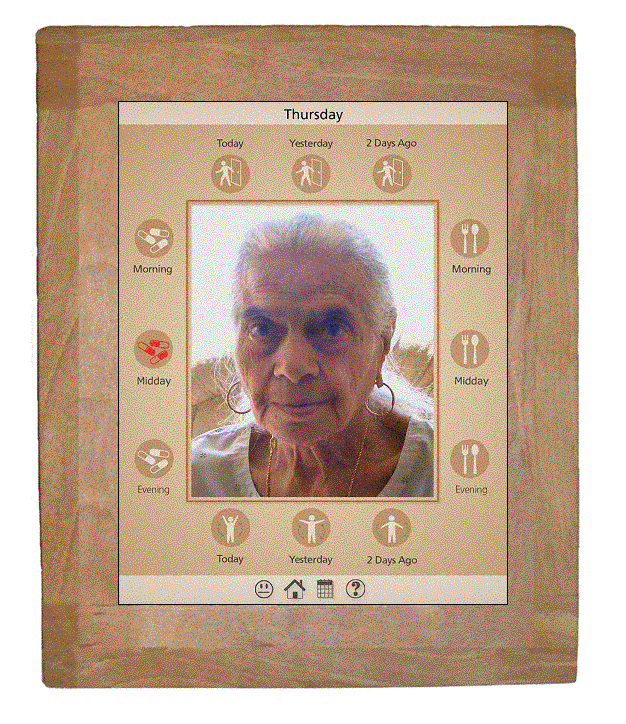Computer-Supported Coordinated Care / CareNet Display
In this project, we investigated the many people who provide an older adult with the care that they need to remain at home (i.e., "age in place"). These people – often family, friends, and neighbors of the older adult – comprise the older adult's care network. Paid help, such as professional caregivers, doctors, nurses, pharmacists, and house cleaners, may also be involved. Care network members – particularly family, friends, and neighbors – face many challenges. For several of these members, caring for the older adult is an important but secondary focus, as they have their own families, careers, and problems to manage.
The CareNet Display was our first prototype to help the local members of the older adult's care network to provide the older adult with care and coordinate care-related activities. It was an interactive digital picture frame, inspired in part by Georgia Tech's Digital Family Portrait, that augmented a photograph of an older adult with information about their daily life.
We evaluated the CareNet Display prototype in a 3-week "Wizard of Oz"-style field study in the homes of several members of four different care networks in the Seattle Metropolitan Area.


The CareNet Display Prototype
From the CareNet Display's main screen (above), users could get an overall picture of the older adult's current condition while passing by, or interact with the display by touching the icons which represent medications (left), outings (top), meals (right), and activities (bottom). Along the very bottom of the display from left to right are icons where the user could get more information for the older adult's mood, household chore needs, and their calendar.
Care network diagram for "Grace"
In Grace's care network diagram, the circles represent the members of her network (the inner light-gray oval include local members, and the outer darker-gray oval includes the members of her care network who live at a distance). Lines show communication flow (thickness represents volume). White lines represent communications about, but not directly with, Grace.
CSCC-related publications
S. Consolvo, F.R. Bentley, E.B. Hekler, S.S. Phatak, “Mobile User Research: A Practical Guide,” Synthesis Lectures on Mobile and Pervasive Computing, Morgan & Claypool Publishing, (2017).
S. Consolvo & J. Towle. “Evaluating an Ambient Display for the Home,” CHI ’05 Extended Abstracts on Human Factors in Computing Systems, Portland, Oregon, (2005), pp. 1304-7.
S. Consolvo, P. Roessler, & B.E. Shelton. “The CareNet Display: Lessons Learned from an In Home Evaluation of an Ambient Display,” Proceedings of the 6th International Conference on Ubiquitous Computing: UbiComp ’04, Nottingham, England, (2004), pp.1-17.
S. Consolvo, P. Roessler, B.E. Shelton, A. LaMarca, B. Schilit, & S. Bly. “Technology for Care Networks of Elders,” IEEE Pervasive Computing Magazine: Successful Aging, 3(2), (2004), pp. 22-9.